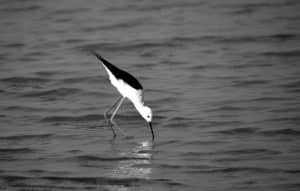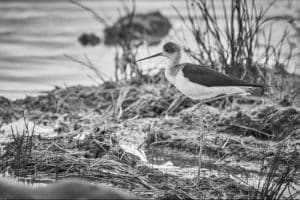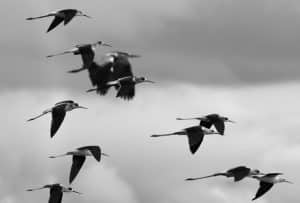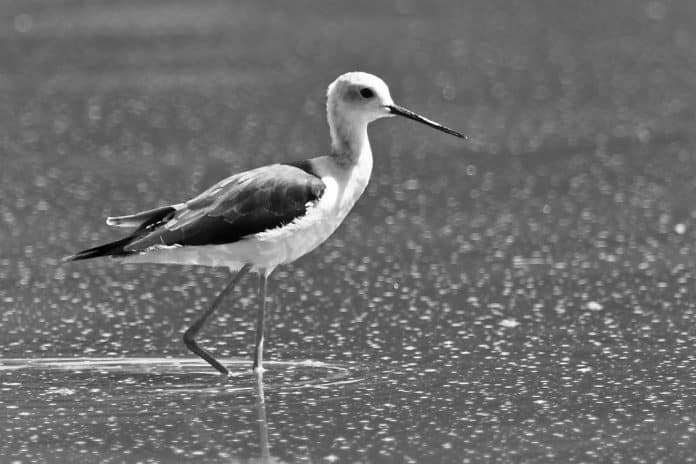Introduction to the Black-Winged Stilt
The Black-Winged Stilt, scientifically known as Himantopus himantopus, is a graceful and elegant bird found in the wetlands of Tanzania. With its long, thin legs and distinctive black and white plumage, this avian species is a sight to behold. The Black-Winged Stilt in Tanzania is known for its ability to wade in shallow waters with ease, using its long legs to search for food. In this article, we will explore the habitat, physical characteristics, breeding behavior, feeding habits, migration patterns, and conservation status of the Black-Winged Stilt in Tanzania.
Habitat and Distribution of the Black-Winged Stilt in Tanzania

The Black-Winged Stilt is widely distributed across Tanzania, particularly in the wetland areas of Lake Manyara, Lake Victoria, and the Rufiji River Basin. These birds prefer habitats with shallow freshwater or brackish waters, such as swamps, marshes, and lagoons. They can also be found in coastal areas and salt pans. The wetlands of Tanzania provide the ideal environment for the Black-Winged Stilt’s foraging and breeding activities, as well as protection from predators.
Physical Characteristics of the Black-Winged Stilt
The Black-Winged Stilt is easily recognizable due to its unique physical features. It has long, thin black legs that enable it to wade effortlessly in the water. The body of the bird is slender and elongated, with a black and white plumage that contrasts sharply. The bill of the Black-Winged Stilt is long and pointed, allowing it to probe the mud or shallow water for prey. The male and female birds have similar appearances, making it difficult to distinguish between the two based on physical characteristics alone.
The average length of the Black-Winged Stilt is around 35-40 centimeters, with a wingspan of approximately 75-80 centimeters. Despite its delicate appearance, this bird is a skilled flier and can travel long distances during migration.
Breeding and Nesting Behavior of the Black-Winged Stilt
The breeding season for the Black-Winged Stilt in Tanzania typically begins during the rainy season, which provides the necessary conditions for nesting. These birds are monogamous and form pairs that stay together throughout the breeding season. The male performs an elegant courtship display, showcasing its long legs and calling out to attract a mate.
The female Black-Winged Stilt constructs the nest, which is usually a shallow depression in the ground lined with grass, twigs, and other plant materials. The nests are often located near the water’s edge, providing easy access to food. The female typically lays a clutch of three to four eggs, which are incubated by both parents for about 22 to 26 days.
Once the eggs hatch, the chicks are precocial, meaning they are born with downy feathers and are capable of walking and feeding themselves shortly after birth. The parents take turns feeding and protecting the chicks until they are old enough to fend for themselves.
Feeding Habits of the Black-Winged Stilt

The Black-Winged Stilt is a skilled forager, primarily feeding on small aquatic invertebrates, such as insects, crustaceans, and mollusks. It uses its long, slender bill to probe the mud or shallow water, searching for prey. The bird has excellent eyesight, allowing it to spot its prey even in murky water. It also feeds on small fish and amphibians, depending on the availability of food in its habitat.
The Black-Winged Stilt employs a unique feeding technique called “foot-trembling,” where it rapidly shakes one leg in the water to stir up small invertebrates, making them easier to catch. This behavior is often observed when the bird is foraging in shallow waters.
Migration Patterns of the Black-Winged Stilt in Tanzania
The Black-Winged Stilt is a migratory bird, with some populations in Tanzania undertaking long-distance journeys. During the dry season or when their wetland habitats become unsuitable, these birds migrate to other regions with more favorable conditions. They may travel to countries in East Africa, such as Kenya or Uganda, or even cross the Indian Ocean to reach Madagascar.
The migration patterns of the Black-Winged Stilt vary depending on the specific population and environmental factors. Some individuals may remain in Tanzania year-round if their wetland habitats provide sufficient resources throughout the year.
Conservation Status of the Black-Winged Stilt
The Black-Winged Stilt is classified as a species of least concern on the IUCN Red List of Threatened Species. While this bird is not currently facing significant conservation threats, its population in Tanzania and other East African countries could be impacted by habitat loss and degradation due to human activities. The destruction of wetlands for agriculture, infrastructure development, and pollution can have detrimental effects on the Black-Winged Stilt’s breeding and foraging habitats.
Efforts are being made to protect and conserve the wetlands of Tanzania, which are vital for the survival of the Black-Winged Stilt and many other bird species. Conservation organizations and government agencies are implementing measures to raise awareness, promote sustainable land use practices, and establish protected areas to safeguard these important ecosystems.
The Importance of East African Wetlands for the Black-Winged Stilt
The wetlands of East Africa, including those in Tanzania, play a crucial role in the life cycle of the Black-Winged Stilt. These wetlands provide essential breeding grounds, foraging areas, and resting places for these birds during migration. The availability of shallow waters and abundant food resources in the wetlands make them ideal habitats for the Black-Winged Stilt to thrive.
Additionally, the wetlands support a diverse array of plant and animal species, making them important biodiversity hotspots. Protecting and conserving these wetlands not only benefits the Black-Winged Stilt but also contributes to the overall health and resilience of the ecosystems in East Africa.
Best Places to Spot the Black-Winged Stilt in Tanzania

If you’re an avid birdwatcher or a nature enthusiast, Tanzania offers several excellent locations to spot the Black-Winged Stilt in its natural habitat. One of the best places to see these stylish stilts is Lake Manyara National Park. The park’s shallow alkaline lake and surrounding wetlands provide a perfect setting for the Black-Winged Stilt to feed and breed. Lake Victoria, the largest lake in Africa, is another fantastic destination to observe these birds. The lake’s marshy shores and islands attract a variety of bird species, including the Black-Winged Stilt.
The Rufiji River Basin, located in the Selous Game Reserve, is also worth a visit. This vast wetland complex is home to numerous waterbirds, and the Black-Winged Stilt can often be spotted wading through the shallow waters. These are just a few examples of the many wetlands in Tanzania where you can witness the beauty of the Black-Winged Stilt.
Tips for Birdwatching the Black-Winged Stilt in Tanzania
To enhance your birdwatching experience and increase your chances of spotting the Black-Winged Stilt, here are a few tips:
- Visit wetland areas during the early morning or late afternoon when bird activity is high.
- Bring a pair of binoculars or a spotting scope to get a closer look at the birds.
- Wear neutral-colored clothing to blend in with the surroundings and avoid disturbing the birds.
- Be patient and observant. The Black-Winged Stilt may be camouflaged among the vegetation or actively foraging in the water.
- Respect the birds’ space and avoid approaching too closely, as this may cause stress or disrupt their natural behavior.
- Join a guided birdwatching tour or hire a local birding guide who can help you locate and identify the Black-Winged Stilt and other bird species.
Conclusion
The Black-Winged Stilt is a stunning bird that adds beauty and elegance to the wetlands of Tanzania. Its long legs, graceful movements, and distinctive plumage make it a favorite among birdwatchers and nature enthusiasts. By understanding its habitat, physical characteristics, breeding behavior, feeding habits, migration patterns, and conservation status, we can appreciate the importance of protecting the wetlands that support the Black-Winged Stilt and the rich biodiversity of East Africa. So, grab your binoculars, visit the wetlands of Tanzania, and witness the stylish stilts in action!

































